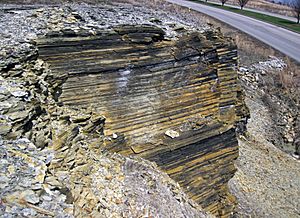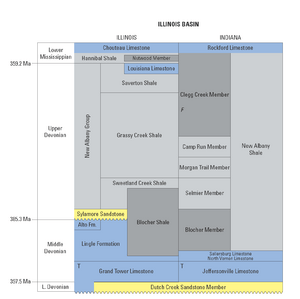New Albany Shale facts for kids
Quick facts for kids New Albany ShaleStratigraphic range: Devonian-Mississippian |
|
|---|---|

New Albany Shale, outcrops in Bullitt County, Kentucky
|
|
| Type | Formation |
| Sub-units | Blocher, Camp Run, Clegg Creek, Lower Blackiston, Morgan Trail & Selmier members |
| Underlies | Hannibal Shale & Rockford Limestone |
| Overlies | Boyle Formation, North Vernon, Sellersburg & Sylamore Limestones |
| Lithology | |
| Primary | Shale |
| Other | Dolomite, limestone, phosphorite |
| Location | |
| Coordinates | 38°42′N 85°42′W / 38.7°N 85.7°W |
| Approximate paleocoordinates | 27°00′S 33°54′W / 27.0°S 33.9°W |
| Region | Illinois, Indiana, and Kentucky |
| Country | |
| Extent | Illinois Basin |
| Type section | |
| Named for | New Albany, Indiana |
The New Albany Shale is a special type of rock found in the Illinois Basin in the United States. It formed millions of years ago during the Devonian and Mississippian periods. This rock is very important because it contains lots of ancient plant and animal material, making it a key source for finding hydrocarbons like oil and natural gas.
What is the New Albany Shale?
The New Albany Shale is mostly made of brown, black, and green shale rock. It also has smaller layers of dolomite (a rock similar to limestone) and sandstone. This rock formed at the bottom of an ancient ocean where there was very little oxygen.
You can often find pyrite (also known as "fool's gold") in the shale. Some parts of the shale have more than 4% of their weight coming from ancient living things. The dark black shale layers have higher levels of natural radioactivity (from tiny bits of uranium), phosphorus, and some heavy metals.
This rock formation was named after the area near New Albany, Indiana, where it can be seen at the surface. The New Albany Shale is similar to other organic-rich shales found across North America from the same time period. These include the Antrim Shale in Michigan, the Ohio Shale in Ohio and eastern Kentucky, and the Chattanooga Shale in Tennessee and central Kentucky.
Layers of the New Albany Shale
The New Albany Shale is made up of six main layers, called "members," stacked one on top of the other from oldest to newest. These layers are:
- Blocher: This is a dark brown to gray-black shale, with a little bit of calcium and pyrite.
- Selmier: This layer is a greenish-gray to olive-gray shale.
- Morgan Trail: This is a dark brown to olive-black shale that splits easily and contains lots of silica (like quartz) and pyrite.
- Camp Run: This layer has greenish-gray to olive-gray shale mixed with brownish-black shale.
- Clegg Creek: This is a brownish-black shale rich in organic matter and pyrite.
- Ellsworth: The bottom part of this layer has mixed brownish-black shale, while the top part is greenish-gray shale.
Natural Resources from the Shale
The New Albany Shale is a very important source of natural gas. People drill wells into this rock formation in southern Indiana and western Kentucky to get the gas.
Experts have estimated that there is a huge amount of natural gas that can be recovered from the New Albany Shale. Early estimates were between 1.9 and 19.2 trillion cubic feet, but more recent estimates suggest there could be as much as 160 trillion cubic feet!
The New Albany Shale also contains a lot of oil shale, which is rock that can produce oil when heated. It's thought that this shale holds billions of barrels of oil.
Scientists also believe that the New Albany Shale is the original "source rock" for much of the petroleum found in older rock formations in the Illinois Basin. They think that major mountain-building events to the east caused the oil to move long distances from the New Albany Shale into surrounding sandstones.


